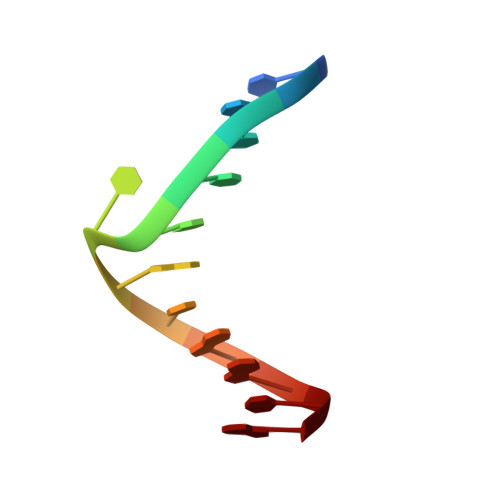Solution structure of a nitrous acid induced DNA interstrand cross-link.
Edfeldt, N.B., Harwood, E.A., Sigurdsson, S.T., Hopkins, P.B., Reid, B.R.(2004) Nucleic Acids Res 32: 2785-2794
- PubMed: 15155847
- DOI: https://doi.org/10.1093/nar/gkh606
- Primary Citation of Related Structures:
1S9N, 1S9O - PubMed Abstract:
Nitrous acid is a mutagenic agent. It can induce interstrand cross-links in duplex DNA, preferentially at d(CpG) steps: two guanines on opposite strands are linked via a single shared exocyclic imino group. Recent synthetic advances have led to the production of large quantities of such structurally homogenous cross-linked duplex DNA. Here we present the high resolution solution structure of the cross-linked dodecamer [d(GCATCCGGATGC)]2 (the cross-linked guanines are underlined), determined by 2D NMR spectroscopy, distance geometry, restrained molecular dynamics and iterative NOE refinement. The cross-linked guanines form a nearly planar covalently linked 'G:G base pair' with only minor propeller twisting, while the cytidine bases of their normal base pairing partners have been flipped out of the helix and adopt well defined extrahelical positions in the minor groove. On the 5'-side of the cross-link, the minor groove is widened to accommodate these extrahelical bases, and the major groove becomes quite narrow at the cross-link. The cross-linked 'G:G base pair' is well stacked on the spatially adjacent C:G base pairs, particularly on the 3'-side guanines. In addition to providing the first structure of a nitrous acid cross-link in DNA, these studies could be of major importance to the understanding of the mechanisms of nitrous acid cross-linking and mutagenicity, as well as the mechanisms responsible for its repair in intracellular environments. It is also the shortest DNA cross-link structure to be described.
Organizational Affiliation:
Department of Chemistry, University of Washington, Seattle, WA 98195, USA. fredrik.edfeldt@astrazeneca.com














